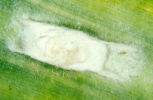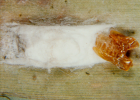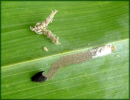Scientific name
Epiricania melanoleuca (Fletcher) (=Epipyrops melanoleuca Fletcher)
Taxonomic position
Lepidoptera: Epipyropidae
Diagnosis
The parasitised nymphs of Pyrilla spp. can be immediately recognised by the presence of fleshy, ellipsoidal larvae with white waxy cover carried on the body of the nymphs. Presence of parasitic larvae on the body of the leafhopper is always indicated by the elevated position of the wing on one side. Boat-shaped white cocoons can be observed on leaves with hopper infestation. Adult moths of both sexes are small, dark brown, triangular in outline, with prominent bipectinate antennae .
Images

 Pyrilla nymph carrying the larvae of E. melanoleuca
Pyrilla nymph carrying the larvae of E. melanoleuca
 Pupa of E. melanoleuca Pupa of E. melanoleuca
 Pupal case after adult emergence Pupal case after adult emergence

 Adult moth Egg laying female
Adult moth Egg laying female
Distribution
Common in northern India. Colonised in several parts of South India, apparently established.
Biology / Hosts
In India, Epiricania (=Epipyrops) melanoleuca (Fletcher) is an external parasite on sugarcane leafhopper (Pyrilla perpusilla (Walker)) and very effective in certain situations. E. melanoleuca has been colonised or redistributed in areas where it was not present or scarce and given very good control.
Eggs are disc-like or ovate, and are laid in groups on the food plants of the host insects. The larvae are somewhat campodeiform in appearance and later instars are fleshy and ellipsoidal, covered with dense, white waxy secretion. More than one larva may be found on the The larvae on full growth separate from the host and pupate in a white, oval, silken cocoon on the leaves. On adult emergence, part of the pupal case protrudes through a horizontal frog-mouth slit at one end of the cocoon. Adults are dark grey and have short, bipectinate antennae in both sexes.
The feeding habits of the larvae have not been determined precisely, but the larva probably ruptures the cuticle of its host with its mandibles and feeds on the haemolymph (Nielsen & Common, 1991). Pierce (1995) listed the Epipyropidae and associated hosts of the world. Very little information in available on the fauna of the Indian region. Fletcher (1919) summarised the systematics of Indian Epipyropidae. Several workers have studied the bionomics of Epiricania melanoleuca on sugarcane pyrilla.
References
- Fletcher, T.B. 1919. Indian Epipyropidae, pp. 979-982. In: Report of the Proceedings of the Third Entomological Meeting held at Pusa, 3rd to 15th February, 1919, Volume III. Government of India Press.
- Nielsen, E.S. & Common, I.F.B. 1991. Lepidoptera, pp. 817-915. In: The Insects of Australia. A textbook for students and research workers. Volume II. 2nd edition. Cornell University Press, Ithaca. 1137 p.
- Pierce, N.E. 1995. Predatory and parasitic Lepidoptera: carnivores living on plants. Journal of the Lepidopterists' Society, 49(4): 412-453.
|